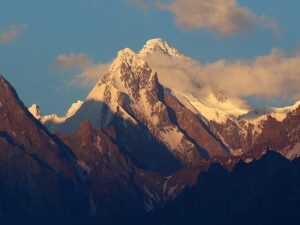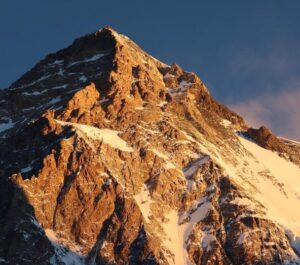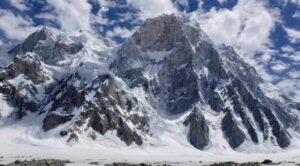After climbing the north ridge of Diran Peak in pure alpine style, Helias Millerioux, Patrick Wagnon, and Yannick Graziani had in mind a golden finish for their Karakorum summer. They moved to the Hunza Valley to climb the always impressive Rakaposhi (7,788m), in the southwestern corner of the Karakorum.
The team has kept quiet about their achievement. Now back in France, Helias Millerioux spoke to ExplorersWeb about it.

Rakaposhi from the southwest. Photo: Karrar Haidri
The team followed the same approach that they had with Diran. They climbed alpine-style a route that had been previously done in the traditional Himalayan manner (setting camps and fixing ropes through several rotations). This time, they chose the WSW ridge, also known as the SW Spur by the British. These early UK teams paved the way for the first ascent by Tom Patey and Mike Banks in 1958.
“We climbed in four days, alpine style, from Base Camp at 4,200m to the summit and back, along the same route,” said Millerioux. “We didn’t know the mountain and couldn’t risk a descent on any other side.”

Helias Millerioux (left) and Patrick Wagnon on the summit of Rakaposhi. Photo: Helias Millerioux
Risk management
“It’s something different from what I usually climb in the Alps, where I look for highly technical faces,” Millerioux explained. “The knife-sharp ridge we climbed on Rakaposhi is not technically difficult, but very, very long and demanding. It provides a totally different experience. You have to bear in mind the variable conditions, altitude, and sheer size. This involves a great deal of risk management, not only to reach the summit but to return afterward.”
This need for careful risk management is why one of them, Yannick Graziani, decided to turn around at 6,900m.
“He was not feeling 100 percent and knew what lay ahead,” said Millerioux. “A long, flat, windswept shoulder below the final summit climb, where our tracks would disappear shortly after we passed on the way up, forcing Patrick [Wagnon] and I to re-open the trail on snow slabs coming down.
“You need to assess your remaining strength carefully, to make sure that you will be okay to endure the descent. When you climb a face, the descent is relatively fast, rappeling down steep terrain and feeling better with every rappel, as you lose altitude. But on this sort of ridge, the descent is long and exhausting. The flatter sections are especially tough in the conditions we found: lots of fresh snow, wind slabs and, lower down, heavy, wet snow.”
We asked Millerioux if the high temperatures had caused problems, as it did other alpine-style teams on Muchu Chhish, Laila Peak, and Dansam Peak.

An exhausting march on a flatter section below the summit pyramid. Photo: Helias Millerioux
Karakorum heat
“It was hot, but we sort of expected it after [hearing about] the previous expeditions in Pakistan,” he said. “It’s different from Nepal in fall, where it’s cold even on sunny days. In the Karakorum summer, when it’s sunny, it gets really hot, and hot weather means bad snow conditions. So climbing super-early is essential, because you must stop and find a safe place for a bivy by noon.”
Fortunately, Rakaposhi gave them a good weather window lasting five to six days.
“On our previous climb of Diran Peak, we had to wait out 24 days of bad weather,” said Millerioux. “We pushed for the summit on the only window we had, which was rather tight, and descended with the storm upon us.”
He admits that they took some risks on Diram. “We had a 200m long traverse on steep, exposed terrain at 6,900m,” he recalled. “Honestly, we were not sure we would be able to traverse back after the summit, because of all the snow.”
Overall, the three Chamonix Mountain guides were elated to reach Pakistan. “There is so much to do there,” said Millerioux.

Rather than being highly technical, the climb was physically and mentally demanding. Photo: Helias Millerioux
Harder to get permits
He added that Pakistan offers more possibilities for lightweight, alpine-style teams looking for new routes or first ascents. In Nepal, it’s becoming harder to arrange logistics and obtain permits for expeditions off the beaten track, as outfitters focus on the more lucrative 8,000’ers. ExplorersWeb has heard similar comments from several international climbers.
Speaking of permits, there was some misunderstanding when the French team reached Pakistan at the beginning of July. Back then, the team’s tracker located them near Shishpare Peak, which led some to think that they were heading for that mountain.
“We were just trekking in the area to acclimatize,” Millerioux explained. “We had no climbing permit for Shishpare. Even if we had, we wouldn’t have dared to get close to its flanks, because of the constant avalanches.”
He also cleared up initial rumors about possible ski descents from the peaks they climbed. “We initially considered climbing Diram and then skiing down, but the narrow weather window and the snow conditions made us think twice,” he said. “We finally opted to climb lighter and faster.”

Millerioux in Rakaposhi Base Camp, with local porters. Photo: Helias Millerioux






